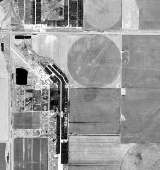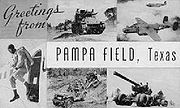
Pampa Army Airfield
Encyclopedia

Pampa, Texas
Pampa is a city in Gray County, Texas, United States. The population was 17,887 at the 2000 census. It is the county seat of Gray County.Pampa is the principal city of the Pampa Micropolitan Statistical Area, which includes all of Gray and Roberts counties....
in Gray County, Texas. During World War II
World War II
World War II, or the Second World War , was a global conflict lasting from 1939 to 1945, involving most of the world's nations—including all of the great powers—eventually forming two opposing military alliances: the Allies and the Axis...
, the United States Army Air Forces
United States Army Air Forces
The United States Army Air Forces was the military aviation arm of the United States of America during and immediately after World War II, and the direct predecessor of the United States Air Force....
used Pampa Airfield as a training airfield by the Army Air Forces Flying Training Command
Air Training Command
Air Training Command is a former major command of the United States Army Air Forces and United States Air Force. ATC came into being as a redesignation of the Army Air Forces Training Command on July 1, 1946...
, Gulf Coast Training Center.
History
Construction of the airfield began in June 1942 under the supervision of the Tulsa, OklahomaTulsa, Oklahoma
Tulsa is the second-largest city in the state of Oklahoma and 46th-largest city in the United States. With a population of 391,906 as of the 2010 census, it is the principal municipality of the Tulsa Metropolitan Area, a region with 937,478 residents in the MSA and 988,454 in the CSA. Tulsa's...
, office of the United States Army Corps of Engineers
United States Army Corps of Engineers
The United States Army Corps of Engineers is a federal agency and a major Army command made up of some 38,000 civilian and military personnel, making it the world's largest public engineering, design and construction management agency...
. The immediate construction involved runways and airplane hangars, with three concrete runways, several taxiways and a large parking apron and a control tower. Four large hangars were also constructed. Buildings were ultimately utilitarian and quickly assembled. Most base buildings, not meant for long-term use, were constructed of temporary or semi-permanent materials. Although some hangars had steel frames and the occasional brick or tile brick building could be seen, most support buildings sat on concrete foundations but were of frame construction clad in little more than plywood and tarpaper. Pampa Airfield was activated on 3 August 1942.
Also known as the "Eagles' Nest of the High Plains," Pampa offered advanced twin-engine training in AT-10s. Also stationed at the field were AT-9s, B-25s, and AT-17s. During the war, Pampa had a total of 4 satellite fields:
- Reeves Aux #1 (6 miles south of Pampa, TX),
- Thompson Aux #2 (6 miles NNW of Pampa, TX), later reused as Perry Lefors Airport,
- Hoover Aux #3 (9 miles northwest of Pampa AAF), of which no trace remains,
- Laketon Aux #4 (9 miles ENE of Pampa AAF), of which no trace remains.
During its three years of operation the base graduated 6,292 cadets, trained 3,500 aircraft mechanics, and had one of the best safety records in the United States Training Command throughout the war.
Advanced flight training ended at Pampa on 28 December 1944 and the base was transferred as a sub-base of Liberal Army Airfield, Kansas
Kansas
Kansas is a US state located in the Midwestern United States. It is named after the Kansas River which flows through it, which in turn was named after the Kansa Native American tribe, which inhabited the area. The tribe's name is often said to mean "people of the wind" or "people of the south...
where it supported the heavy 4-engine training school there. With the end of the war, Pampa AAF was inactivated on 30 September 1945 and transferred to the Army Corps of Engineers. The airfield remained in inactive status until 1948 when it was reopened as Pampa Air Force Auxiliary Field #1. The Pampa airfield remained on the Air Force property rolls until at least 1952, but was then closed again. It was declared excess in 1955, and the last tract of land was sold in 1957 to agricultural interests.
In 1982 a Texas Historical Commission historical marker was placed near the site, at the intersection of Rt.152 & Farm Road 3302. What remains of Pampa Army Airfield today is a broken up parking apron filled with holes and tall grass and one hangar. The runways and taxiways are gone, along with most of the streets of the administrative area. The main entrance to the base can be found, and the outlines of the parade ground stil exist. A few agricultural buildings of postwar vintage use the concrete foundations of their World War II predecessors, and the occasional concrete foundation of a wartime building is found. Most of the administrative area consists of farmers fields or scrubland. The most obvious remnant of AAF use is the concrete water tower which still stands.
See also
- Texas World War II Army AirfieldsTexas World War II Army AirfieldsIn today's United States Air Force, many personnel have spent some of their military service being trained in Texas during World War II. Be it basic military training at Lackland Air Force Base, technical training, officer training, or flight training at other facilities across the state...

